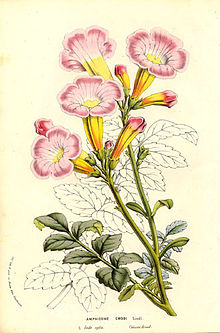Incarvillea: Difference between revisions
m Dating maintenance tags: {{Cn}} |
Tortie tude (talk | contribs) +ref |
||
| Line 14: | Line 14: | ||
|}} |
|}} |
||
'''''Incarvillea''''' is a [[genus]] of 16 species of [[flowering plant]]s in the family [[Bignoniaceae]], native to central and eastern [[Asia]], with most of the species growing at high altitudes in the [[Himalaya]] and [[Tibet]]. The most familiar species is ''Incarvillea delavayi'', a garden plant commonly known as '''hardy gloxinia''' or '''Chinese trumpet flower'''. Unlike most other members of Bignoniaceae, which are |
'''''Incarvillea''''' is a [[genus]] of about 16 species<ref name=china>[http://www.efloras.org/florataxon.aspx?flora_id=2&taxon_id=116396 ''Incarvillea''.] Flora of China.</ref><ref name=chen>Chen, S., et al. (2005). [http://www.amjbot.org/content/92/4/625.full Molecular phylogeny of ''Incarvillea'' (Bignoniaceae) based on ITS and \[bu100\)TRN\(cmL-Fsequences.] ''Am. J. Bot.'' 92(4) 625-33.</ref> of [[flowering plant]]s in the family [[Bignoniaceae]], native to central and eastern [[Asia]], with most of the species growing at high altitudes in the [[Himalaya]] and [[Tibet]]. The most familiar species is ''[[Incarvillea delavayi]]'', a garden plant commonly known as '''hardy gloxinia''' or '''Chinese trumpet flower'''. Unlike most other members of Bignoniaceae, which are mainly tropical woody plants, species of ''Incarvillea'' are herbs from temperate regions.<ref name=chen/> |
||
[[Genetic analysis]] supports the division of the genus into five [[clade]]s: the subgenus ''Niedzwedzkia'', the subgenus ''Amphicome'', the subgenus ''Incarvillea'', the subgenus ''Pteroscleris'', and the species ''I. olgae'', which does not fit into a subgenus. It may be given a subgenus of its own in a future study.<ref name=chen/> |
|||
The tuberous roots are claimed in folklore to repel moles, a claim put to the test by the owners of Raven Valley Nursery in Surrey, England (prior to their retirement).{{cn|date=April 2013}} Planted at ten metre intervals, the mole infestations vanished, an experience repeated on other sites. While the trials are too limited to establish any scientific proof, the clear nature of the observations suggests that further study would be appropriate. |
|||
Incarvillea is named after the French [[ |
''Incarvillea'' is named after the French [[Society of Jesus|Jesuit missionary]] and [[botany|botanist]] [[Pierre Nicolas d'Incarville|Pierre Nicholas Le Chéron d'Incarville]].<ref name=mobot>[http://www.missouribotanicalgarden.org/gardens-gardening/your-garden/plant-finder/plant-details/kc/f255/incarvillea-sinensis-cheron-pink.aspx ''Incarvillea sinensis'' 'Cheron Pink'.] Missouri Botanical Garden.</ref> |
||
Species include: |
|||
;Selected species |
|||
*''Incarvillea altissima'' |
*''[[Incarvillea altissima]]'' |
||
*''[[Incarvillea arguta]]'' |
*''[[Incarvillea arguta]]'' |
||
*''Incarvillea beresowskii'' |
*''[[Incarvillea beresowskii]]'' |
||
*''Incarvillea compacta'' |
*''[[Incarvillea compacta]]'' |
||
*''Incarvillea delavayi'' |
*''[[Incarvillea delavayi]]'' |
||
*''Incarvillea dissectifoliola'' |
*''[[Incarvillea dissectifoliola]]'' |
||
*''Incarvillea emodi'' |
*''[[Incarvillea emodi]]'' |
||
*''Incarvillea forrestii'' |
*''[[Incarvillea forrestii]]'' |
||
*''Incarvillea lutea'' |
*''[[Incarvillea lutea]]'' |
||
*''Incarvillea mairei'' |
*''[[Incarvillea mairei]]'' |
||
*''Incarvillea olgae'' |
*''[[Incarvillea olgae]]'' |
||
*''Incarvillea potaninii'' |
*''[[Incarvillea potaninii]]'' |
||
*''Incarvillea sinensis'' (syn. ''I. variabilis'') |
*''[[Incarvillea sinensis]]'' (syn. ''I. variabilis'') |
||
*''Incarvillea younghusbandii'' |
*''[[Incarvillea younghusbandii]]'' |
||
*''Incarvillea zhongdianensis'' |
*''[[Incarvillea zhongdianensis]]'' |
||
==Gallery== |
==Gallery== |
||
<gallery> |
<gallery> |
||
File:Incarvillea |
File:Incarvillea delavayi 1.jpg|''[[Incarvillea delavayi]]'' |
||
</gallery> |
</gallery> |
||
== |
==References== |
||
{{reflist}} |
|||
*[http://www.efloras.org/florataxon.aspx?flora_id=2&taxon_id=116396 Flora of China: ''Incarvillea''] |
|||
[[Category:Bignoniaceae]] |
[[Category:Bignoniaceae]] |
||
Revision as of 06:40, 29 June 2013
| Incarvillea | |
|---|---|

| |
| Incarvillea emodi | |
| Scientific classification | |
| Kingdom: | |
| (unranked): | |
| (unranked): | |
| (unranked): | |
| Order: | |
| Family: | |
| Genus: | Incarvillea |
| Genera | |
|
See text. | |
Incarvillea is a genus of about 16 species[1][2] of flowering plants in the family Bignoniaceae, native to central and eastern Asia, with most of the species growing at high altitudes in the Himalaya and Tibet. The most familiar species is Incarvillea delavayi, a garden plant commonly known as hardy gloxinia or Chinese trumpet flower. Unlike most other members of Bignoniaceae, which are mainly tropical woody plants, species of Incarvillea are herbs from temperate regions.[2]
Genetic analysis supports the division of the genus into five clades: the subgenus Niedzwedzkia, the subgenus Amphicome, the subgenus Incarvillea, the subgenus Pteroscleris, and the species I. olgae, which does not fit into a subgenus. It may be given a subgenus of its own in a future study.[2]
Incarvillea is named after the French Jesuit missionary and botanist Pierre Nicholas Le Chéron d'Incarville.[3]
Species include:
- Incarvillea altissima
- Incarvillea arguta
- Incarvillea beresowskii
- Incarvillea compacta
- Incarvillea delavayi
- Incarvillea dissectifoliola
- Incarvillea emodi
- Incarvillea forrestii
- Incarvillea lutea
- Incarvillea mairei
- Incarvillea olgae
- Incarvillea potaninii
- Incarvillea sinensis (syn. I. variabilis)
- Incarvillea younghusbandii
- Incarvillea zhongdianensis
Gallery
References
- ^ Incarvillea. Flora of China.
- ^ a b c Chen, S., et al. (2005). Molecular phylogeny of Incarvillea (Bignoniaceae) based on ITS and \[bu100\)TRN\(cmL-Fsequences. Am. J. Bot. 92(4) 625-33.
- ^ Incarvillea sinensis 'Cheron Pink'. Missouri Botanical Garden.

